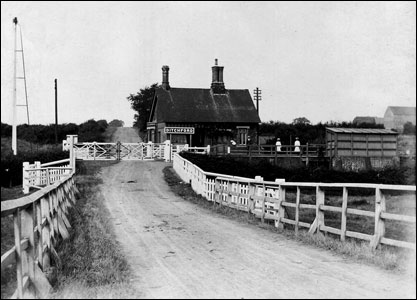 |
(above) The Station about 1920 and (below) a Vic Childs photograph of gipsy caravans parked at Rushden end of Ditchford Lane which leads to the station. Also at the bottom of the lane stands Ditchford Mill, close to the spot where bathing in the river was popular.
|
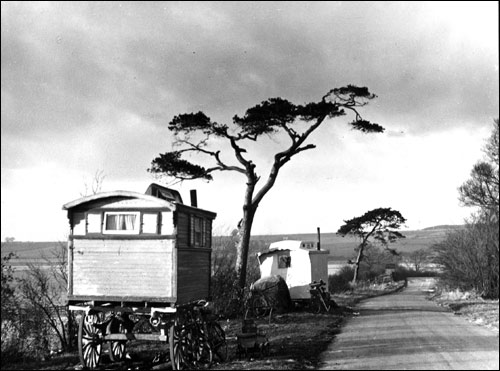 |
The road to Ditchford from Rushden was just a lane, but it was a main route for travellers going north, to Finedon and Kettering. Trains would have drawn the young boys from the villages to see these monsters steaming along the track, and with the river alongside, it became a local attraction for picnics and for swimming. In 1895 Rushden Council approached currier and farmer, Thomas Sanders of Rushden Hill (Higham Road) to ask if he would allow them to establish a “Public Bathing” area at Ditchford. The stationmaster in the 1940s used to sell ice cream and drinks to the visitors and would do good trade on Bank Holidays. This use continued into the 1960s.
Ditchford Lane was also regularly used by gypsy families who would camp there for a few weeks at a time and then move on. There was a succession of caravans almost year round pitched at the top the lane close to where the A45 slip road, on the north side, runs today.
Behind the railway station there was a large area, in Irthlingborough parish, where iron ore was mined. It is said that molten iron looks much like treacle and this was the basis of the tales told to children about the ‘treacle mines’ at Ditchford. The trains would cart away much of the ore and in 1912 a siding was built to facilitate this.
The railway was part of the Northampton to Peterborough line and continued from Ditchford to Irthlingborough Station. This station was half way between Higham Ferrers and Irthlingborough, close to the river but strangely stood just inside the parish bounds of Chelveston, together with the Fitzwilliam Arms next door. [station now demolished, Fitzwilliam Arms a house]
Arthur George lived at Irthlingborough Station where his father was stationmaster, and as a boy would go to visit the master at Ditchford on occasions. Arthur was very well known in the area as he became a photographer and would also film events around the locality. He eventually moved to Rushden and lived in Washbrook Road where he had his studio.
Ditchford Station was the closest to Rushden. A local coach and horses could take travellers to and from the station until Rushden finally got a station in 1893 but this was only a branch line to Wellingborough.
The station masters, period & sources:
|
Thomas Barwis Hodgson
|
|
1851 census
|
|
John Burton Green
|
|
1871 census
|
|
Joseph Hooton
|
|
Buried at Irchester 1882 aged 52
|
|
Matthew Philip Hunt
|
|
Trade Directories & Irchester Electoral Rolls
|
|
Frederic William Mitchell
|
|
Irchester Electoral Rolls
|
|
John Lymage
|
|
1901 Census & family
|
|
Samuel James Peck
|
|
Irchester Electoral Rolls
|
|
Cecil Smart
|
|
Irchester Electoral Rolls
|
|
Tom Tasker Haddon
|
|
Irchester Electoral Rolls
|
|
Albert Adams
|
|
Ronald Adams
|
1898 - 1925
John Lymage (sometimes Limage or Limmage) lived at Saxby’s Cottages in Irthlingborough with his wife Sarah Elizabeth, son John William and daughter Annie Ellen (Lizzie) when the stationmaster’s post came vacant. John was born at Buckden, HUN, his wife was from Stanwick and their son was born at Lilbourne before they came to Irthlingborough in 1898. Their daughter was born soon after they arrived.
In 1918 Sarah Lymage was brought before the court at Wellingborough for obtaining food without a ration book (she had not received book) and the Co-op at Irchester was summonsed for supplying her with the food. John was also charged, but their defence said they “lived three miles from anywhere” and it was confirmed that a mistake had been made. The judge ordered that the case against Mrs Lymage be withdrawn, her husband was charged 4s costs and the Co-op was fined 7guineas with 3 guineas costs. (Northampton Mercury, 11th Nov 1918)
John William Lymage had joined the 7th Battalion Royal West Regiment in May 1915. He was discharged on 10th Dec 1919, from the 12th Royal Lancers. The inscription on the family grave in Irthlingborough Cemetery reads:
In ever loving memory of John, the dearly beloved husband of Sarah Elizabeth Lymage who died June 17th 1928
aged 65 years.
Also their beloved son John William, 12th Royal Lancers who died June 3rd 1927 after 10 years suffering, aged 35 years.
Also their beloved daughter Annie Ellen Dickens who died April 14th 1978 aged 80 years.
Also her beloved husband Sidney Dickens who died November 16th 1982 aged 83 years.
Re-united.
|
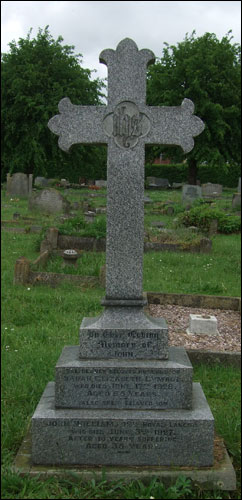 |
|
Further research: J. W. Lymage born Lilbourne joined the Police Force on
4th April 1912. He was promoted to 2nd class Constable 1st Nov 1912,
and resigned 31st March 1915 (presumably when he joined the Army)
|
1924 - 1950
Ditchford station finally closed to passenger traffic in 1924 and goods in May 1950. For those 26 years it had been just a crossing and the station master was responsible for opening the gates to let motor traffic through, and closing them again for the trains to pass through.
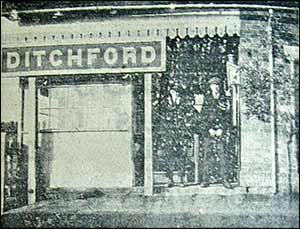 |
|
A Scene of unusual activity – Two people on Ditchford Station platform at the same time.
|
|
Wellingborough News, 1924
Ditchford Closes Down
Tiny Station that had an Average of Three Passengers Daily
A signal near the little branch-line station is down; the level crossing gates are open; and the branch-line train draws up by the narrow platform. A porter shouts “Ditchford!” and looks along the line of carriages. No one dreams of getting out; there is no one to think of getting in; and the train goes on its way, leaving the station to slumber again.
Such was the scene many times enacted during past years at the dreamy, dreary little station of Ditchford, on the L.M.S. line between Wellingborough and Irthlingborough. Such—alas!—is the scene that has ceased to be enacted, for Ditchford Station, like Wembley, closed last week.
Bent on discovering The Truth About Ditchford, or Why Stationmasters Leave Home, our representative visited Ditchford Station this week. A directory does not recognise such a place as Ditchford, but nevertheless, a mile ot two from Rushden, such a place does exist. A porter at the station, when sufficiently recovered from the shock of seeing a human being, answered a question to that effect by pointing to the station premises and saying, majestically, “This is Ditchford.”
So this was Ditchford! A building about the size of one of the Government houses included: 1, the stationmaster’s residence, 2, the booking office, 3, the waiting room, and 4, a general waiting-room, signal-box, level crossing control box, weighing office and store-room. A very narrow platform, with two lonely-looking oil lamps, bearing the legend “Ditchford” and another tiny platform on the opposite side of the line, with a hutch-like building representing a waiting-room shelter, gave an atmosphere of dreariness. Dreariness was everywhere; on a dark, rainy night the rails would gleam cold and bright in the light of the platform lamps; the lamps would gleam out desolately over the flooded meadows round this spot of man’s creation. Ugh! Even the crisp, bright autumn could not banish the atmosphere of desolation.
There was a time when this station served as a jumping-off place for Rushden inhabitants. Business men would drive to Ditchford if they wished to go to Peterborough or Northampton, and (let it be said with shame) newly-weds would escape to their honeymoon via Ditchford. Now a stationmaster and a porter are sufficient to deal with all the traffic that comes along. Up to last week Ditchford boasted of about three passengers per day, and had five regular trains; and if a passenger wanted to catch a train not due to stop, the porter had to resort to the expedient of setting the signal against the train. Then would Ditchford swell with pride.
Ditchford, then, is closed to passengers, and only goods traffic is allowed. What a blow to the district! Mention of Ditchford brought a smile to the face of anyone who knew the district. No longer will passengers look out of carriage windows and ask the guard why they were stopping, and where was Ditchford anyway? The magic legendary that has surrounded the station will disappear.
But, with all these tragedies, Ditchford will still have its curiosities and adventures. The mere fact, for instance, that the platform is so narrow that one has to lean back on to the platform railings to allow trains to pass, gives a spice of adventure.
Only the other day, a dog dashed down the hill leading to the level crossing, rushed through the crossing gates—just as a train passed. Amid tense excitement, pieces of the dog were found further up the line.
Attaditchford!
|
Rushden Echo April 1939, transcribed by Peter Brown
Entire Change of Station Staff - Mr Albert Adams takes over at Ditchford.
A new Stationmaster has taken up duties at Ditchford, the one-man L M S station and level crossing between Wellingborough and Irthlingborough, in the person of Mr Albert Adams, a Yorkshireman. He has a wife and 13-year-old son.
In spite of the remote situation of their wayside station home, Mr and Mrs Adams and their son are equipped with gas masks, which they brought with them.
When he was offered the position, in succession to Mr Tom Haddon, who has retired and is now living with his family in Rushden, Mr Adams paid three visits of inspection to Ditchford before making up his mind about it.
“I was given the opportunity to come here because my health has not been too good” he explained to a reporter. Surveying the panorama of Nene Valley floods lapping near the station, he added “I think Ditchford is healthy, don’t you? Why it’s like the seaside just now”.
Plenty To Do
Mr Adams has had 33 years on the railway. He was previously keeper of a busy L M S crossing at Rubery, near Birmingham. He finds the new job not quite so exacting, although there is plenty to do opening and shutting the crossing gates for road traffic and passing through about 24 trains a day.
But Sunday is a day of rest – no trains run on the line.
During the week only one train stops at Ditchford. It is the 11.45 on Saturday mornings, and it brings Mr Adams’s wages. Mrs Adams has the privilege of stopping a train if she wishes to go shopping at Northampton, but so far she has not done so.
When this one-man station was “discovered by one of our reporters a few years ago, Mr Tom Haddon became a film star, as a news film company sent down a mobile unit to take “shots” of him at the crossing gates.
Formerly Ditchford was quite a busy station, handling agricultural produce from farms in the neighbourhood, but it is no longer in demand for goods or passengers. Only attention to the crossing gates prevents the station from being closed down.
From Paul Wright: Mr Ron Adams worked all of his life as a railway signalman, and one of his final tours of duty was at the temporary signal box which was installed at Sharnbrook in a portacabin building. This was only there for a few weeks while they were connecting the signalling up to the power box at West Hampstead to fill in the so called "Leicester gap"in 1987.
Ron told me that he really loved the job over the many years in the boxes, and was even stranded in the signal box between Wymington & Sharnbrook during a really bad snow storm over several days. All in all he'd enjoyed his job, but his biggest regret was all those years of "shift work". |
|
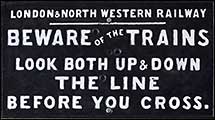 |
|
This sign was rescued from the water during renovation in the 1970s to the locks at Ditchford.
|
|
| In January 2001 Irchester Historial Society, Irthlingborough Historical Society and Rushden & District History Society worked together to gather all they could find about Ditchford. A book was published in 2003, 'Ditchford Days - A Historical Investigation'. |
|




